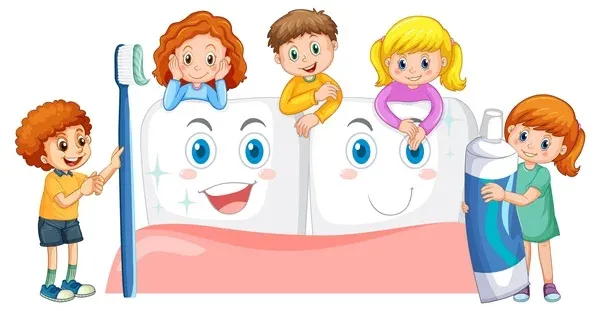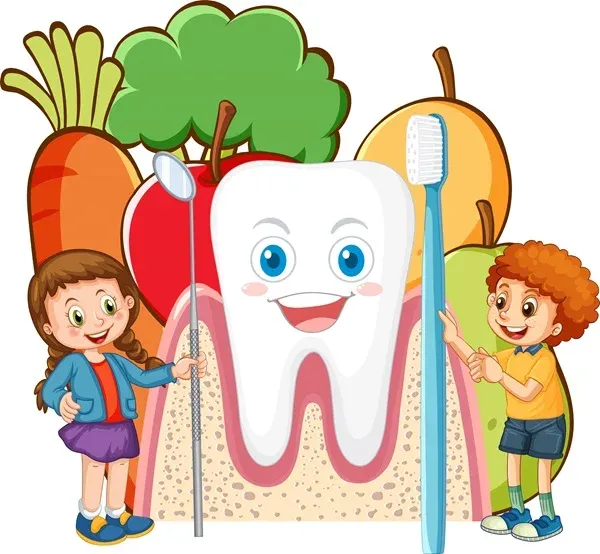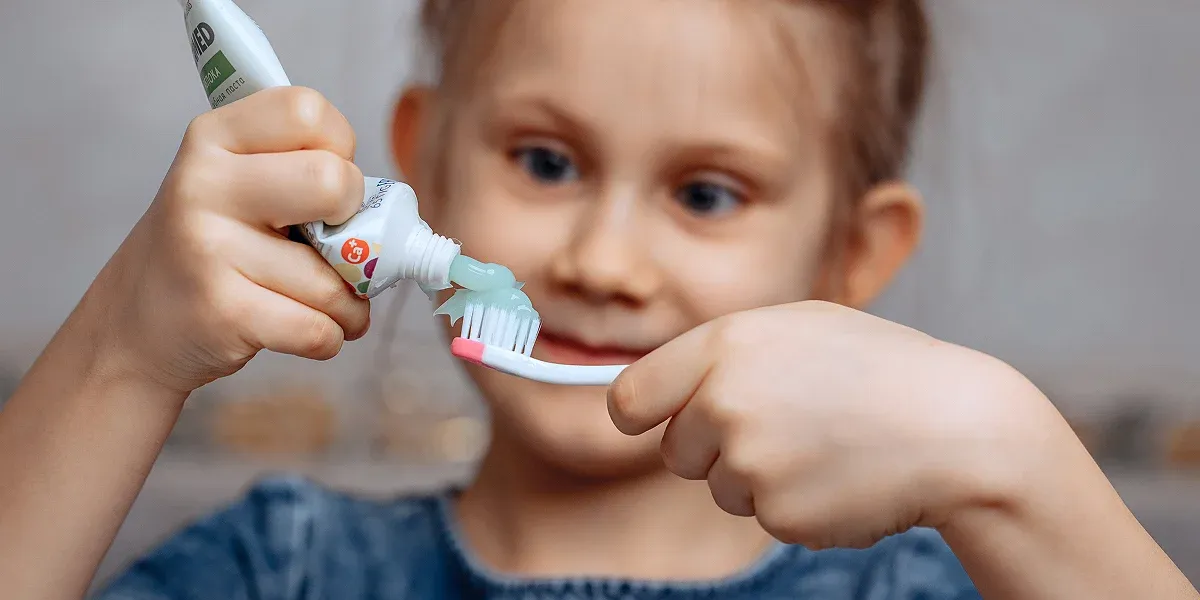
Understanding Growth and Development
Insights into Children's Dental Growth and Development Stages and How Parents Can Support These Processes
While dental growth refers to the increase in size and the continuous emergence of teeth, dental development is a broader concept. It includes the entire process of tooth formation, eruption, and maturation.
Dental development includes a combination of genetic and environmental factors and involves distinct stages that contribute to the overall structure and arrangement of the dentition. During children's oral development, significant milestones shape the foundation of their dental health.
Understanding these stages provides insights into the intricate process of tooth formation, eruption, and maturation. Parents can contribute to their children's dental growth and development by actively engaging in good practices.
It then sets the stage for a lifetime of good oral health habits. Regular dental care, a nutritious diet, and positive oral hygiene practices create a foundation for a healthy and vibrant smile.
Dental Growth Vs. Development: What's the Difference?
Dental growth kicks off with the appearance of primary teeth during infancy. It then progresses through a complete set of primary teeth and continues with permanent teeth. These include molars and wisdom teeth. Each tooth contributes to the evolving landscape of your child's smile.
Conversely, dental development commences with tooth buds forming beneath the gums, moving through calcification, eruption, and maturation. Genetic factors, environmental elements, and nutritional support influence it. Dental development shapes not only the physical structure of the teeth but also their arrangement and overall well-being.
"Around 42% of children develop cavities by entering kindergarten. Empowering parents with insights into dental growth stages is the first defense against this silent epidemic".
Why Does It Matter to Parents?
- Early Intervention Opportunities: Recognizing the differences allows parents to spot potential issues early on. Early intervention is often more effective and less invasive.
- Promoting Good Oral Habits: Understanding dental growth and development aids in establishing good oral habits. It encourages regular dental check-ups, proper hygiene routines, and a tooth-friendly diet.

- Navigating Orthodontic Considerations: Recognizing the difference helps parents understand when orthodontic assessments might be necessary. It provides a proactive approach to potential alignment concerns.
- Informed Decision-Making: With knowledge, parents can make informed decisions about their child's oral care. From choosing the right toothpaste to understanding the importance of regular check-ups, this understanding guides decisions that impact long-term oral health.
Insights into Children's Dental Growth and Development: Stages Up to Adolescence
Infancy (0-6 months)
In the initial weeks of fetal development, tooth buds form beneath the gums. These buds represent the precursor to primary teeth, even though they are not yet visible. The timing and sequence of tooth bud formation are affected by genetics.
Even though teeth are not yet visible, maintaining a clean and healthy oral environment is crucial during infancy. Parents can cultivate positive oral hygiene practices by softly wiping the baby's gums with a gentle, damp cloth after feeding. It eliminates bacteria and lays the foundation for subsequent dental care.
Frequent exposure to sugary substances, even in milk, can contribute to developing early childhood cavities. Proper feeding practices are crucial for maintaining oral health. Prolonged use of pacifiers or thumb-sucking beyond infancy may impact the alignment of emerging teeth.
Although the eruption of primary teeth usually begins around six months, the teething process can start earlier. Teething may cause discomfort, leading to increased drooling, irritability, and a tendency to put objects in the mouth. Parents can provide teething rings or gentle gum massages to alleviate discomfort.
Teething (6-24 months)
Subsequent teeth gradually appear until the child has a complete set of 20 primary teeth by age two. Teething challenges often accompany the emergence of baby teeth. Understanding and addressing these challenges are integral to supporting the child through this developmental phase. Parents gradually transition from wiping the gums to brushing the new teeth as teeth emerge.
Teething also coincides with the introduction of solid foods. Parents should be mindful of the child's diet, avoiding sugary snacks and encouraging the consumption of tooth-friendly foods. The link between nutrition and dental health becomes increasingly relevant during this stage.
The teething stage allows parents to monitor the sequence and timing of tooth eruption. Keeping track of tooth development enables early identification of potential orthodontic considerations, ensuring timely professional intervention.
Toddlerhood (2-3 years)
Toddlerhood introduces the child to independent oral care practices. While manual dexterity develops, parents may still ensure thorough brushing using a child-sized toothbrush and a small amount of fluoride toothpaste. The focus is on instilling the habit of brushing daily.
The eruption of a complete set of primary teeth coincides with transitioning to a more diverse diet. Parents play a role in influencing dietary choices by introducing various nutritious foods that support general health and dental well-being.
Routine dental check-ups become part of the toddler's oral health journey. Dental professionals monitor tooth development, assess oral hygiene practices, and guide parents in maintaining a healthy oral environment for their children.
Preschool (3-6 years)
Preschoolers experience the ongoing eruption of primary teeth, contributing to the development of 20 primary teeth. This phase involves the emergence of molars, further enhancing the child's ability to chew and process various foods.
Preschoolers can actively participate in oral hygiene practices as they gain more independence. The focus expands to include proper flossing techniques and fostering comprehensive oral care habits. Routine dental visits become more integral during the preschool years. Dental professionals offer preventive measures such as sealants to protect newly erupted molars from decay.
Mixed dentition (6-12 years)
The mixed dentition stage, from 6 to 12 years, marks a transitional period where a child experiences the coexistence of primary and permanent teeth. This stage often prompts the need for orthodontic assessments.
Dentists evaluate the alignment of teeth and jaw development, identifying any early signs of misalignment or malocclusion. Early interventions, such as orthodontic treatments, may be recommended to address potential issues.
As permanent teeth increase, maintaining adequate oral hygiene practices becomes crucial. Children, with guidance from parents and dental professionals, should brush and floss regularly to prevent decay and ensure the health of both primary and permanent teeth.
Adolescence (12-18 years)
One significant aspect of adolescence is wisdom teeth eruption, also known as third molars. This process typically occurs in late adolescence and may bring challenges such as impaction, misalignment, or crowding.
Regular dental check-ups are crucial during this period to monitor the development of wisdom teeth and address any issues promptly. Comprehensive orthodontic assessments are common during adolescence. Dentists evaluate the alignment of teeth, jaw structure, and bite functionality.
In cases of impaction or crowding, dentists may recommend wisdom teeth extraction to prevent complications such as infection, pain, or damage to adjacent teeth. Adolescents are encouraged to maintain diligent oral hygiene practices, including regular brushing, flossing, and mouthwash use.
As the complete set of permanent teeth is in place, preserving their health and preventing issues like cavities or gum disease becomes paramount. Protective gear, including mouthguards, is emphasized for adolescents engaged in sports.
How Parents Can Support These Processes: A Guiding Hand for Healthy Smiles
- Early Education and Guidance: Educate children about the importance of oral hygiene from an early age.
- Regular Dental Check-Ups: Introduce children to the dental environment positively to alleviate potential fears.
- Nutrition and Diet: Encourage a balanced diet rich in calcium and vitamin D for healthy tooth development. Limit sugary snacks and beverages to promote overall oral health.

- Orthodontic Considerations: Be attentive to signs of misalignment or orthodontic issues and seek professional advice.
- Wisdom Teeth Management: Monitor the eruption of wisdom teeth and seek guidance from dental professionals. Address any complications, and if necessary, consider wisdom tooth extraction.
- Cultivating Lifelong Habits: Reinforce the importance of consistent oral hygiene practices into adulthood. Advocate for the continuation of regular dental check-ups for ongoing maintenance.
Concluding Thoughts
Exploring the complex stages of children's dental growth focuses on the significance of practical care and education. Parents can significantly influence their child's smile by staying informed and dedicated, ensuring it flourishes with health and confidence for years. Let's take action together to prioritize our children's dental health. Schedule regular check-ups and maintain good oral hygiene habits to set them on the path to a lifetime of radiant smiles and well-being.
Contact your kids' dentist in Stockton, Dr. Sajjad Rizvi, D.D.S. at Happy Kids Dental, to understand the growth and development of Children's dental care.
Resource:
The Importance of Pediatric Dentistry: Why It Matters?
*This media/content or any other on this website does not prescribe, recommend, or prevent any treatment or procedure. Therefore, we highly recommend that you get the advice of a qualified dentist or other medical practitioners regarding your specific dental condition*
Subscribe To Our Newsletter
Get Updates And Learn From The Best


